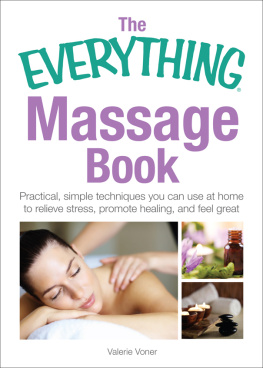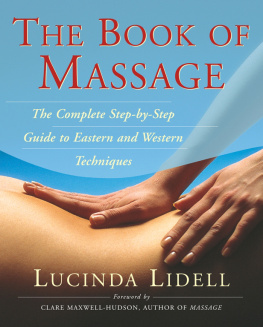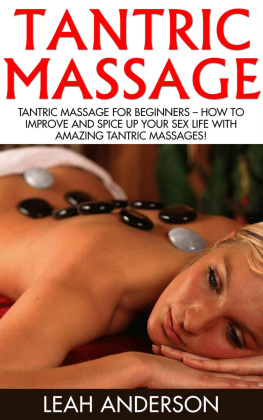Text 2003 Katy Dreyfuss, www.apieceofpeace.com
Illustrations 2003 Mark Busacca
All rights reserved. No part of this deck may be reproduced in any form without written permission from the publisher.
eISBN: 978-0-8118-7315-4
Chronicle Books LLC
680 Second Street
San Francisco, CA 94107
www.chroniclebooks.com

The Massage Deck
by Katy Dreyfuss
Have you ever offered a massage to a friend, then realized you didnt know what to do? Have you ever received a massage that didnt feel quite right? You can use The Massage Deck to improve your massage skills, as well as to communicate your desires with others when its your turn to receive a massage.
These 50 cards contain information about how to massage specific areas of the body. If you take a few minutes to learn the basics and practice the methods, you can become a skillful healer.
How to Use The Massage Deck
Use the table of contents on the back of this card to identify your areas of interest. Each card is coded by body zone to help you organize your massage sequence. Refer to the Recommended Sequences lists for a 20- or 60-minute full-body massage or for specific combinations to ease common problems. With practice, you will become comfortable improvising original massage moves. Whether you want to give a therapeutic massage to ease pain or a sensual massage to express affection, you can create unique sequences every time you give a massage.
Preparation and Tools
You can give a massage almost anywhere; all you really need is a peaceful, focused mind and a little time.
An ideal massage room is comfortably warm, quiet, and private. Turn off phone ringers and turn down answering machines. If the massage receiver will be reclining undressed, provide two clean sheets, one as a grounding sheet, the other as a drape for warmth and modesty. Lay blankets or sleeping bags beneath the grounding sheet to pad hard surfaces. When giving a massage on a bed, which generally provides less support and space than a floor or table, keep your session brief (under 15 minutes) to avoid injury to the giver. Place a pillow under the knees of a face-up reclining receiver, and under the ankles of a face-down reclining receiver.
You can transform a normal space into a sensuous haven with candlelight, aromatherapy (incense, candles, or mist), and soft music. To prepare yourself, remove rings, watches, and bracelets, roll shirtsleeves above your elbows, and wash your hands and forearms.
When choosing a lubricant, keep it simple and pure. Lotions, creams, and oils blended specifically for massage provide a smooth glide without being too slippery or quickly absorbed. Warm the lubricants in your hands before applying them to the receivers body. If no moist lubricant is available, use talcum powder.
Before you begin a massage, choose your card sequence and read each card. Ask the receiver about physical or emotional conditions that might affect the massage. Certain conditions are especially noteworthy: Pregnant women in their first trimester should receive light massage, with no contact on the belly and very light pressure on the lower back. If the receiver is using painkillers (including aspirin), do not apply deep pressure, because the receivers sensitivity might be limited. In general, children and senior citizens should receive shorter massages (20 minutes). Do not directly massage over acute inflammation, bleeding, bruises, broken bones, skin infections, or open wounds. If the receiver is receiving medical treatment or has recently completed surgery, contact the medical provider to ask about massage precautions. You can also consult a professional massage therapist.
The Massage: Communication, Body Dynamics, and Breath
Encourage the receiver to communicate both pleasure and discomfort during the massage. Invite feedback concerning exact location of pressure points, amount of pressure, temperature in the roomanything at all. Do not be offended by constructive criticism; use the feedback to fine-tune your techniques and notice how you improve with every session.
Depending on your relationship with the receiver, you might want to leave the room while he undresses. Invite the receiver to remove jewelry and to undress to his comfort level. Remind him to cover himself with the sheet before you return. Knock before you return to the room.
Introduce the concept of a pressure scale, 1 being very light and 10 being painful. When using deep pressure, aim for an 8, a pressure balanced between pleasure and pain, erring on the side of pleasure. Receivers who feel too little sensation might become bored or frustrated. Receivers who feel pain might react by contracting muscles instead of relaxing.
Listen to your bodys feedback as well. In general, the more comfortable you are, the more comfortable your receiver will be. To apply deep pressure, position your body so that you can lean your body weight into the stroke instead of pushing with muscle strength alone. Maintain a long spine. When standing, step one leg forward and bend your front knee to lower your body toward the receiver.
Combined with body dynamics, your breath is also a powerful tool. When you lean or press into a stroke, exhale. When you release a stroke, inhale. When you hold a position, breathe in cadence with the receiver.
In general, relaxation massages begin with light pressure and gradually increase in pressure as needed. The Stillness Polarity Hold () is a graceful finale.
The next time a friend seems stressed or overwhelmed, offer your assistance by sharing The Massage Deck and your caring touch. When you need a helping hand, choose the appropriate massage cards and show a friend exactly what you would like to receive. The Massage Deck helps you receive or deliver relief through a personally designed massage. Add a little love to your efforts and success is guaranteed.
Recommended Sequences
Headaches
Direct Scalp Massage ()
At the Office (seated, no lubricants)
Direct Scalp Massage ()
Repetitive Stress
Steamroller Full-Back Stroke ()
20-Minute Massage
Stillness Polarity Hold ()
60-Minute Massage
Stillness Polarity Hold ()
Soft Touch (no lubricants)
Stillness Polarity Hold ()
Note:Not all massage techniques are suitable for everyone. The receivers physical condition and health are important factors in determining which massage strokes, positions, and advice may be appropriate. This or any other exercise program may result in injury. The author and publisher of this deck disclaim any liability from any injury that may result from the use, proper or improper, of any technique or advice contained in this deck. Please consult your professional healthcare provider for information and advice on the suitability of your exercise program.
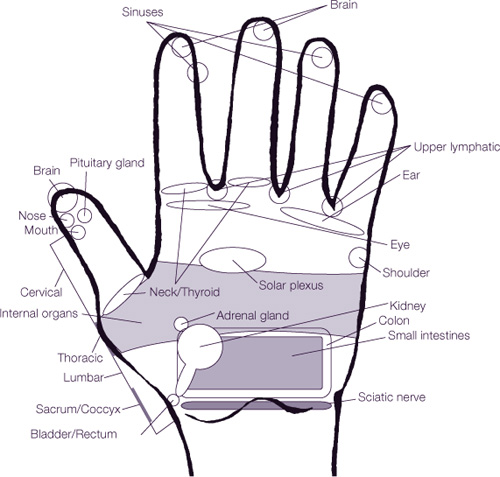
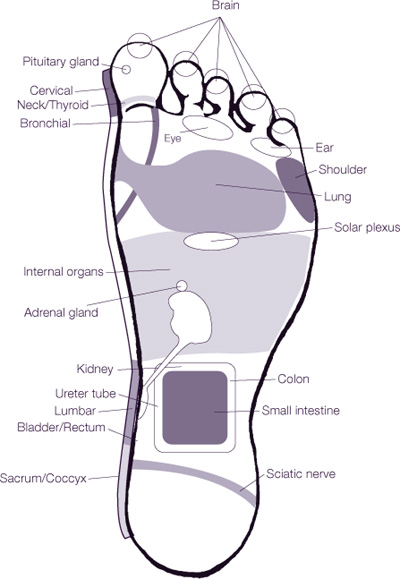
1 Reflexology Card
Refer to the diagram on the front of this card to view the reflexology points in the hands and feet that correspond to all other areas of the body. If there is sensitivity in the reflexology point, there may be a problem in the corresponding part of the body. Press on the sore points until the pain decreases or disappears. To stimulate or balance the energy in a certain area of the body, pinch the related area for 3 seconds.
Next page

